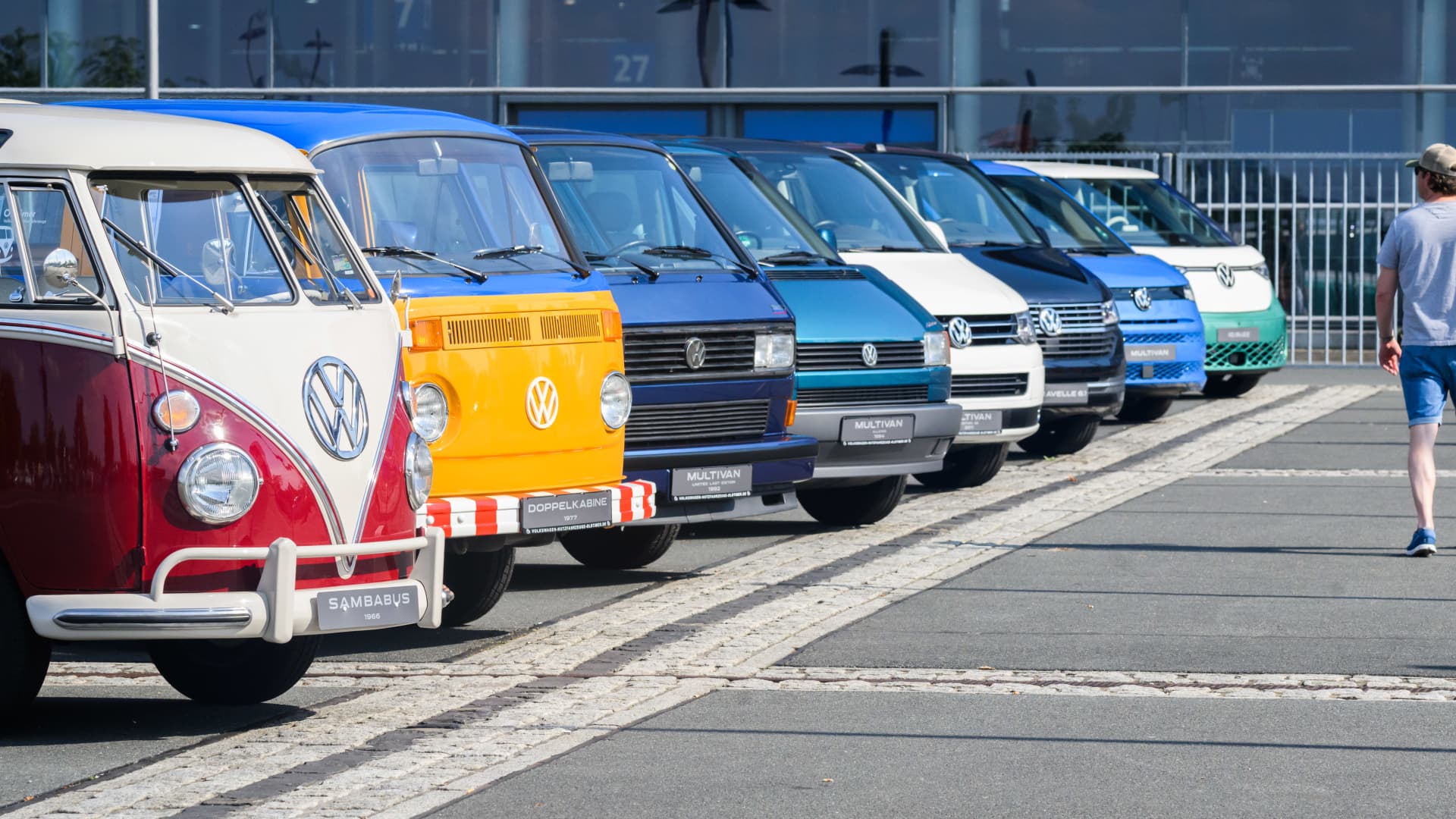The Volkswagen Type 2 bus, known for its split windows, rear engine and distinctive colors, is making a comeback. In 2024, Volkswagen will deliver its electric ID Buzz line to North America.
The “bus,” as many fans know it, is deeply ingrained in American culture and evolved into a symbol of protest starting in the 1960s.
“There was an unpopular war. There were conflicting ideas of what the American dream was,” said Damon Ristau, the director and producer of “The Bus” documentary. “That culture grabbed on to these vehicles.”
As counterculture movements spread through the states, the bus was aligned with antiwar protests and hippies, and even was used by civil rights activists to transport schoolchildren in the segregated South.
From 1950 to 2003, four generations of the Type 2 bus were sold in the U.S., with nearly 1 million total deliveries, according to VW. The last generation imported to the U.S. was the T4 “Eurovan” model.
“After the Eurovan, the minivan segment was sort of on the decline,” said Jeffrey Lear, product manager of electric vehicles for Volkswagen of America. “The van segment in the U.S. comes with a lot of baggage. There are a lot of feelings that come with buying a van.”
Worldwide, VW has delivered nearly 19 million Type 2 buses since its inception, including the T5 through T7 generations which are still being developed in Europe, according to the company. With the ID. Buzz, VW is hoping to change up the narrative.
“It’s our modern interpretation of what we believe a bus is like for the future,” said Lear. “We’ll never call this a van or a minivan from Volkswagen of America. For us, this is a new segment. It is the bus segment.”
“There are a lot of people that have been very excited about this day for over 20 years,” said Ristau. “It’s sort of a homecoming reunion.”
The North American model will have three rows, a maximum of seven seats and a 91 kWh battery, but VW hasn’t released any details on the range or price. However, it says the range is comparable to the ID4, which has a maximum range of 275 miles per charge.
“It’s larger than our ID4,” said Lear. “And since this is a larger battery, you would think it’d get more. But when you take a look at this thing, you realize that it’s much larger and much less aerodynamic than an ID4. So, I think you can expect probably a hair under that figure,” he said.
In the past, the bus has been built all over the world, from VW’s native Germany to South Africa and Australia.
Currently, VW is assembling the electric ID.4 in Chattanooga, Tennessee, but it told CNBC it has no plans to extend that production to the ID Buzz, even with the Biden administration’s EV incentives.
“For now, we plan to just keep it in Europe,” said Lear.
Production will take place at VW’s Hannover, Germany, plant and it will be exported globally. Europe has already started presales of the model and the North American version is expected to arrive at dealers by 2024.
Watch the video to learn more about the evolution of the VW bus and its electric future.

where to buy ivermectin for humans – order candesartan pill cost carbamazepine 200mg
isotretinoin 40mg oral – linezolid 600mg without prescription buy zyvox 600mg generic
buy amoxil no prescription – buy ipratropium pills for sale ipratropium 100 mcg cost
order azithromycin 250mg pills – order tinidazole generic order bystolic for sale
buy prednisolone generic – buy azithromycin 500mg sale oral prometrium 100mg
brand gabapentin 600mg – neurontin 600mg tablet order sporanox 100 mg online cheap
how to get lasix without a prescription – buy nootropil 800mg generic betamethasone 20 gm price
buy generic augmentin 625mg – duloxetine 20mg generic duloxetine 40mg canada
rybelsus where to buy – vardenafil online buy cyproheptadine pills
tizanidine tablet – hydroxychloroquine canada buy hydrochlorothiazide
cialis overnight – viagra cost buy sildenafil 50mg without prescription
cenforce 100mg sale – order glucophage 500mg sale order glycomet 1000mg pills
order lipitor generic – buy amlodipine 5mg generic purchase lisinopril generic
depo-medrol order online – buy depo-medrol paypal order aristocort 10mg for sale
cytotec medication – diltiazem 180mg us diltiazem price
order acyclovir online – order acyclovir for sale order rosuvastatin pills
purchase domperidone – buy flexeril paypal cyclobenzaprine 15mg cheap
domperidone pill – buy cyclobenzaprine tablets flexeril order
inderal order – buy clopidogrel pill methotrexate 10mg canada
buy cheap coumadin – brand metoclopramide cozaar sale
order levaquin 500mg generic – oral avodart 0.5mg zantac where to buy
meloxicam 15mg usa – meloxicam 15mg us brand tamsulosin
buy ondansetron medication – oral spironolactone 100mg simvastatin medication
order valacyclovir 500mg sale – propecia price forcan order online
order provigil 100mg generic buy provigil 100mg without prescription buy provigil pills for sale how to get modafinil without a prescription buy modafinil sale order modafinil online buy provigil sale
This is a keynote which is near to my fundamentals… Numberless thanks! Quite where can I find the connection details in the course of questions?
This is a question which is virtually to my fundamentals… Diverse thanks! Unerringly where can I notice the phone details an eye to questions?
zithromax online buy – buy tinidazole cheap buy flagyl for sale